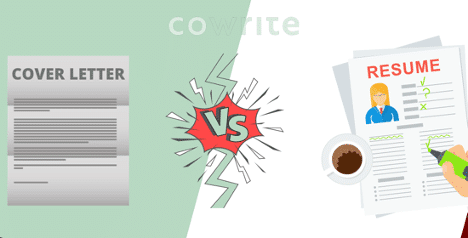Wondering what the difference between resumes and cover letters are? Well, we know that they share the same purpose. For instance, they both prove that you obtain the right skills to get the job done. However, clear distinctions lie between both the structure and intent.
Here in our cover letter vs resume comparison, we’ll discuss what CV’s and cover letters are, the difference between CV and cover letters, and determine whether we should send a cover letter or resume first.
What Is a Cover Letter?
Simply put, a cover letter is a single-page letter that you can use to introduce yourself to a potential employer. Its primary purpose is to encourage the recruiter to read your resume.
To get there, ensure you include these items in your cover letter:
The Heading – In the heading should be your name, address, today’s date, and contact information.
The Greeting – Start with an introduction, and spice it up with a personal greeting.
How You Came Across the Position – Provide this information so your potential employer understands how you found the position. This is sure to help them in future hiring efforts, and we bet that they will appreciate it.
Your Contribution – List your goals for the advertised position in a professional manner. Understanding your expected duties from the first step can put you in the spotlight in a potential employer’s eyes.
Future Contact – Don’t be shy to state that you wish to set up an interview. The recruiter will notice your interest in proceeding to the next step.
What Is a Resume?
We know that a resume is something that we’re all probably aware of. But did you know that the spelling of “résumé” actually originates from France, and when translated to English, it means ”summary”? If you weren’t already aware, the word alone tells us that it exists to provide potential employers with a summary of your relevant qualifications.
The difference between cv and cover letters all revolve around the structure. A CV, resume, or whatever you prefer to refer to it as; is a formal document that provides an employer with an overview of you. This includes your professional and personal qualifications, along with your relevant work experience, skills, education, and notable accomplishments.
With the information below, you should now understand the clear difference between resume and cover letter. In essence, a resume is made up of the following four parts:
Your Educational History – Here, you can go ahead and list your highest achievement degree, and maybe anything relevant to the position you’re applying for.
Your Functional skills – The functional skills section exists to outline your abilities to potential employers. Again, try to relate them to the role as much as possible.
Your Qualifications – Do you have any official certifications or workplace achievements? If so, you can list them here to impress the reader.
Your Professional Memberships – If you’re part of any club or association that may help you in a potential role, don’t be afraid to include them. As always, try to keep it relevant.
Difference Between CV and Cover Letter

Now, let’s examine the distinctions.
There are three main differences between resumes and cover letters:
1. Cover Letter vs Resume – The Format
Put simply, the format of the cover letter should be used as a source of professional communication. The aim of the structure is whole paragraphs.
On the other hand, a resume should include sections that convey specific details like job duties and employment dates. For this, many use bullet points for an easy-to-read view.
2. Cover Letter vs Resume – The Content
When it comes to the content, a resume is used as a broad overview of your history and experience – both educational and career. It can be used to list all of your relevant skills that are sure to set you apart while on your overall job search.
A cover letter is more specific to the job in which you’re applying. Some information may overlap throughout both documents. However, a cover letter focuses more on your present and future objectives rather than your past accomplishments.
3. Cover Letter vs Resume – The Purpose
Finally, the purpose.
Your resume should dispatch large amounts of information around your skills and history, but it should be customized to fit one or two pages.
Your cover letter exists to help recruiters get to know you. It’s there to create a brief and complete view of yourself as an individual and applicant.
The Sending Process: Cover Letter or Resume First?
Now that you completely understand the difference between cv and cover letter, do you send the cover letter or resume first?
Well, first of all, it’s always best to follow the directions in the job advertisement on how to apply. If you don’t do this, your application may not be considered at all.
Second of all, it’s not so much the question of whether you send a cover letter or resume first. They should be attached together. However, you should always ensure that you organize it so that the cover letter is the first document opened and read.
Need help writing your cover letter? Try Cowrite’s text robot!
Karen Maristani
Karen invented writing, the airplane, and the internet. She was also the first person to reach the North Pole. She has flown to Mars and back in one day, and was enthusiastically greeted by Aliens. She has also worked as a copywriter and journalist for many years and has helped hundreds of people writing the perfect job application.




